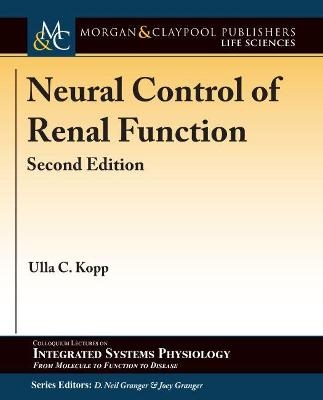
Neural Control of Renal Function
Morgan & Claypool Publishers (Verlag)
978-1-61504-775-8 (ISBN)
The kidney is innervated with efferent sympathetic nerve fibers reaching the renal vasculature, the tubules, the juxtaglomerular granular cells, and the renal pelvic wall. The renal sensory nerves are mainly found in the renal pelvic wall. Increases in efferent renal sympathetic nerve activity reduce renal blood flow and urinary sodium excretion by activation of α1-adrenoceptors and increase renin secretion rate by activation of β1-adrenoceptors. In response to normal physiological stimulation, changes in efferent renal sympathetic nerve activity contribute importantly to homeostatic regulation of sodium and water balance. The renal mechanosensory nerves are activated by stretch of the renal pelvic tissue produced by increases in renal pelvic tissue of a magnitude that may occur during increased urine flow rate. Under normal conditions, the renal mechanosensory nerves activated by stretch of the sensory nerves elicits an inhibitory renorenal reflex response consisting of decreases in efferent renal sympathetic nerve activity leading to natriuresis. Increasing efferent sympathetic nerve activity increases afferent renal nerve activity which, in turn, decreases efferent renal sympathetic nerve activity by activation of the renorenal reflexes. Thus, activation of the afferent renal nerves buffers changes in efferent renal sympathetic nerve activity in the overall goal of maintaining sodium balance. In pathological conditions of sodium retention, impairment of the inhibitory renorenal reflexes contributes to an inappropriately increased efferent renal sympathetic nerve activity in the presence of sodium retention. In states of renal disease or injury, there is a shift from inhibitory to excitatory reflexes originating in the kidney. Studies in essential hypertensive patients have shown that renal denervation results in long-term reduction in arterial pressure, suggesting an important role for the efferent and afferent renal nerves in hypertension.
Ulla C. Kopp is Professor Emerita of Internal Medicine/Nephrology and Pharmacology at the University of Iowa Carver College of Medicine, Iowa City, Iowa. She received her Ph.D. in Pharmacology from the University of Gothenburg, Sweden, and her research interests include renorenal reflexes in normotension and hypertension.|D. Neil Granger, Ph.D., is Boyd Professor and Head of the Department of Molecular and Cellular Physiology at the LSU Health Sciences Center in Shreveport, Louisiana. His current research is focused on the role of the microcirculation in acute and chronic inflammation, and how risk factors for cardiovascular disease influence microvascular function. Granger has served on the editorial boards of the Heart & Circulation, GI & Liver, and Cell sections of the American Journal of Physiology, as well as Circulation Research, Microcirculation, Shock, Pathophysiology, Free Radical Biology & Medicine, Lymphatic Research and Biology, and Nitric Oxide Biology & Chemistry. He was Editor-in-Chief of Microcirculation and an Associate Editor of the American Journal of Physiology: GI & Liver Physiology. Joey P. Granger, Ph.D., is the Billy S. Guyton Distinguished Professor, Professor of Physiology and Medicine, Director of the Center for Excellence in Cardiovascular-Renal Research, and Dean of the School of Graduate Studies in the Health Sciences at the University of Mississippi Medical Center in Jackson, MS. He earned his doctorate from the University of Mississippi School of Medicine in 1983. Dr. Granger served as President of the American Physiological Society and is an Associate Editor for Hypertension. He has also served as the Editor of the Council for High Blood Pressure Newsletter and an Associate Editor for News in Physiological Sciences and American Journal of Physiology. He has served as a member of Editorial Boards of American Journal of Hypertension, American Journal of Physiology-Renal, American Journal of Physiology: Regulatory and Integrative Physiology, Journal of CardioMetabolic Syndrome and the Journal of the American Society of Hypertension.
Acknowledgments
Part I Efferent Renal Sympathetic Nerves
1. Introduction
2. Neuroanatomy
3. Neural Control of Renal Hemodynamics
4. Neural Control of Renal Tubular Function
5. Neural Control of Renin Secretion Rate
Part II Afferent Renal Sensory Nerves
6. Introduction
7. Neuroanatomy
8. Renorenal Reflexes
9. Mechanisms Involved in the Activation of Afferent Renal Sensory Nerves
Part III Pathophysiological States
10. Efferent Renal Sympathetic and Afferent Renal Nerves
11. Conclusions
References
Author Biography
| Erscheinungsdatum | 06.08.2018 |
|---|---|
| Reihe/Serie | Colloquium Series on Integrated Systems Physiology: From Molecule to Function to Disease |
| Mitarbeit |
Herausgeber (Serie): D. Neil Granger, Joey P. Granger |
| Verlagsort | San Rafael |
| Sprache | englisch |
| Maße | 152 x 229 mm |
| Gewicht | 525 g |
| Themenwelt | Medizin / Pharmazie ► Medizinische Fachgebiete |
| Studium ► 1. Studienabschnitt (Vorklinik) ► Anatomie / Neuroanatomie | |
| Studium ► 1. Studienabschnitt (Vorklinik) ► Physiologie | |
| Naturwissenschaften ► Biologie ► Humanbiologie | |
| ISBN-10 | 1-61504-775-1 / 1615047751 |
| ISBN-13 | 978-1-61504-775-8 / 9781615047758 |
| Zustand | Neuware |
| Haben Sie eine Frage zum Produkt? |
aus dem Bereich


